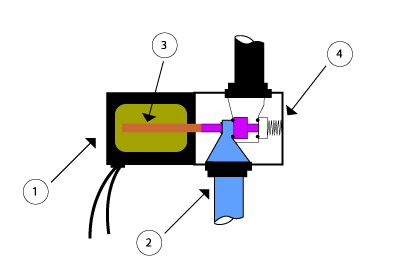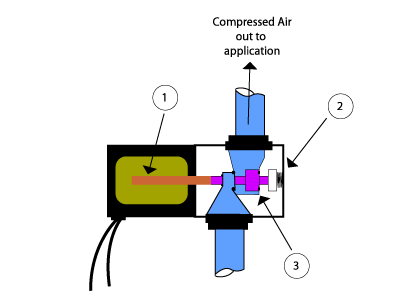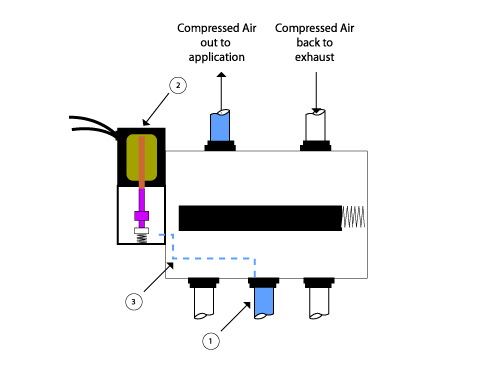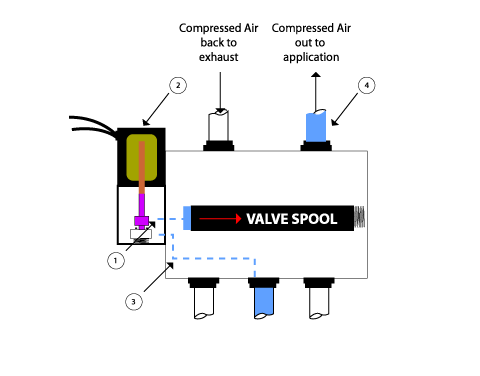Solenoid valves are electrically operated valves that exhaust air that remains in a compressed air circuit when the compressor is idle. There are different types of solenoid valves, and this article will provide you with all the relevant information to gain a greater understanding.
Table of Contents
- What is a Solenoid Valve?
- What Does a Solenoid Valve Do?
- Different Types of Solenoid Valves
- Solenoid Valve Buying Considerations
- FAQs (Frequently Asked Questions)
What is a Solenoid Valve?
Solenoid valves are used in a wide array of applications because their variants cover nearly any application for fluid or materials. A solenoid valve is one of a host of different ways to operate compressed air valves. Other valve actuators include manual levers, push buttons, palm buttons, roller cams, and whisker switches, to name just a few.
Also referred to as an electrically operated valve, they use magnetic forces to serve their purpose. Electrical current passes through the solenoid coil which generates a magnetic field that causes a metal rod to actuate.
This basic process opens the valve and works either directly or indirectly in the air. Solenoid valves can be normally open (N/O), when the valve remains open when the solenoid is not charged, or normally closed (N/C), when the valve remains closed when the solenoid is charged. I’ll discuss how to select the right solenoid valve later.
When I write about the various methods to actuate an air valve, I use the term actuator to refer to the electrical or mechanical device that shifts the internal workings of an air valve. I use the term operator to refer to the person that moves the lever or pushes the button to actuate the valve. For more information on air, valves visit our guide!
Why Use a Solenoid Valve?
Solenoid valves allow you to eliminate the requirement of manual or pneumatic control of a pneumatic circuit. Solenoid valves only require electrical input to operate effectively making them far easier to program and install on a wide array of applications. Though one type, the piloted valves, require air pressure as well as electrical input but we’ll get into that further down the page.
Why Not Use a Solenoid Valve?
A solenoid actuator is a neat device. Maybe it makes you wonder if all you need is a solenoid and electricity to make things move, why compressed air circuit designers even use air actuators at all if a solenoid can move things with just electricity. Why not just use solenoids to do work instead of air cylinders?
While a solenoid coil can generate sufficient force to move a small, very light object over a very short distance, the movement distance and the weight of the item being moved are limited by the relatively weak force generated by an electric coil.
It would take a huge electric coil to move any meaningfully sized device over a distance greater than about 1/10th to 1/8th of an inch. To have a coil actuator that would do larger physical work, like moving some heavy tooling 18″ for example, the coil would be massive.
The coil size and the cost of the coil to move that large object that distance can be replaced by a relatively small air cylinder using the power of compressed air to easily do so.
What Does a Solenoid Valve Do?
Solenoid valves take up the role of removing remaining pressurized air when it’s not in use. When an air compressor system is operating, compressed air is created and stored in its air receiver tank. During this stage, power is provided to the solenoid valve and the circuit closes, keeping it under pressure.
When the air inside the tank reaches the cut-off pressure, the pressure switch stops the motor, and the check valve keeps the air inside the tank. To prevent the compressor from remaining under pressure for too long and potentially even undergoing damage, the solenoid valve de-energizes and exhausts air still in the circuit.
Different Types of Solenoid Valves
There are two key types of solenoid valves, and these are:
- Direct Acting Solenoid Valves
- Piloted Solenoid Valves
Now, let’s look at each in more detail!
Direct Acting Solenoid Valve
Direct-acting solenoid valves must have a force generated by the solenoid greater than the force exerted by the pressure of air. These types of solenoid valves can operate in vacuum conditions without the requirement of any line pressure to work.
Normally closed direct-acting valves have their solenoid rod attached to a spool and kept in place by spring. The magnetic field from being charged causes the solenoid rod to lift, and at the same time moving the spool to allow air to pass out its other side. Normally open valves, work exactly opposite – the spring instead keeps the spool in the open position.
Direct Acting Solenoid Valve Example
On the valve in the image below is a coil, this coil operates the valve via magnetic force.

In this drawing, item #1 is the coil, and inside the black exterior are the coil windings, depicted by the gold color. Item #2 depicts the compressed air supply to this small 2/2 normally closed valve. The 2/2 refers to a two-position, two-ported valve.
Note: how the compressed air enters the valve through the supply port, and is blocked from flowing through the valve by a poppet (purple color). The poppet is sitting on an “O” ring or some sort of rubbery surface, thus sealing the incoming air stream from flowing through the valve and out the other port.
The coil on this valve drawing is de-energized, meaning that electricity is not flowing to it, and the internal valve actuator, the spring (located on the right in the drawing) is in control at this time, shutting off the airflow. The solenoid actuator, when it is energized with electricity, creates a magnetic field.
That electrical field will move the rod piece, item #3 (brown color in the image above), inside the coil housing. The magnetic field will move the rod piece to the right. Since the rod piece is attached to the poppet inside the valve, when the coil is energized and the rod piece is moved by the magnetic field, the poppet will move as well.
Item #4 (image above) depicts the outer valve body. The arrow is pointing towards the internal valve actuator, the coil spring.
Operation of this 2/2 air valve

When the solenoid is energized the coil creates a magnetic field pulling the rod piece to the right as shown in the drawing above. The poppet, connected directly to the pole piece, also shifts item #3, moving off one seat and onto another, now allowing the compressed air to flow through the valve.
Item #2 points toward the inner valve actuator, the coil spring. It has now been compressed by the force generated by the coil and the movement of the rod piece and the poppet to the right. As long as the coil has power to it, this spring will stay compressed, the air path will be open, and air will flow through the valve.
When this direct acting solenoid valve is de-energized, the return spring shifts the poppet and the pole piece the other way inside the valve, and the compressed air is, once again, blocked.
If it is true, and it is, that compressed air valves that are actuated by a direct-acting solenoid must be small, limited in size because solenoids cannot generate large force over a long distance, what can we use to accomplish shifting larger air valves electrically?
We use a small air valve, with a small solenoid, and use the air through that small solenoid to provide the shifting forces needed for a larger air valve.
A small valve ensures that the poppet or spool that controls the airflow inside that valve is even smaller yet.
Being a small valve attached to a larger valve, it is lightweight, with even smaller internal components. Small valves poppets or spools only must move a limited distance to open or close the flow path inside themselves, meaning a quite high force-to-shift ratio for reliable operation of the mini-solenoid valve operators.
Advantages of Direct Acting Solenoid Valves
Some positives include the fact that direct-acting solenoid valves are the first choice when low pressure (under 25 PSI) air pressure is being controlled, or the valve is controlling a vacuum. Since there is limited, or no, air pressure available to help shift a valve poppet or spool in the main valve, either the valves controlling low pressure or vacuum are small enough to be operated with a direct-acting solenoid valve, or they must be operated via other means.
Direct-acting solenoid valves can be very, very small, with extremely low electrical demands. This is ideal for circuits that need the solenoid valves powered right from a PLC (Programmable Logic Controller) or, perhaps with the min-valves installed right onto a circuit board.
Direct-acting solenoid valves operate very quickly. I recall one time I was giving a demonstration to a group of maintenance engineers on the relative merits of a particular brand of the air valve. I used an oscilloscope that could generate a wave on the screen to demonstrate that the little direct-acting valve I was demonstrating was cycling over 200 times per second.
That is over 200 hertz! Opening, allowing air to flow, and closing, shutting off the compressed air, more than 200 times every second. That sort of response time is limited to valves operated with the lightning-like response of electricity.
Direct-acting solenoid valves are relatively inexpensive to manufacture which is why air valve engineers are always trying to maximize flow through the small, direct-acting valve.
They keep trying to increase the airflow capacity throughput without enlarging the body of the valve. If the valve body is small, the coil only must move the pole piece a very short distance and can generate maximum force over that short distance for greater reliability.
Disadvantages of Direct Acting Solenoid Valves
Direct-acting solenoid valves are of limited use and can only really be found in about 10% of applications. This is due to their flow limitations and how they consume a large amount of electrical power.
Some negatives to directing acting solenoid valves include the fact that direct-acting solenoid valves have, by nature of how they operate, to be quite small. That means flow paths are small too with relatively limited airflow.
If the compressed air supply is full of water, water vapor, compressor oils, rust, and scale from the black pipe, then small direct acting solenoid valves may tend to stick more often than their larger, more powerful, cousins.
Water and crud that comes down the airline can deposit crud inside the valve body. Compressed air is pretty much filthy. It has water. It has dust. It has pipe scale. Lots of “stuff” to get inside the air valve.
Then, between operations, the valve sits idle. Shut down for an hour or two, overnight, or for days. What happens is that the gunk deposited inside the valve from the airflow dries out and essentially glues the moving parts of the valve together. When the valve is signaled to fire again, the force generated by the small coil cannot overcome the stickiness inside the valve body, and bingo, you have a stuck valve.
If the application calls out for a physically large valve with higher compressed airflow, and the large air valve cannot be operated with a direct-acting solenoid coil, what happens when you need to use a solenoid actuator to operate a bigger valve?
Solenoid Piloted Air Valve
Solenoid piloted valves can either be internally or externally piloted. They work in a similar fashion in that they work with system pressure to aid control rather than against it. They are, therefore, capable of controlling air flow using far less power than is exerted by the pressure within the line.
With internally piloted air valves, a smaller passage between the line and cavity behind the spool is gated by the solenoid. When this is opened, the pressure within the line opens the valve by pushing the spool across.
These types of solenoid valves require far less power to move compared to the directing acting solenoid valve because the solenoid is controlling a far smaller opening.
Externally piloted air valves work in the same manner as internally piloted air valves but instead, use air from an external force rather than the pressure within the valve to assist movement. The external air source is fed into an extra port on the valve and must come from upstream, or even on a separate circuit.
Externally piloted valves are typically used in low pressure, vacuum, or alternative porting scenarios, where there is low, negative, or no pressure in the valve itself to facilitate any movement.
Solenoid Piloted Air Valve Example

In the drawing just above I show a small, direct-acting solenoid valve, item #2, installed on the end of a much larger spool valve. The small valve provides the energy source to shift the spool in the big valve.
Item #3 shows the supply line of compressed air to that small, direct-acting solenoid valve. The air supply to the small air valve is siphoned internally from the compressed air supply to the main valve. The small direct acting pilot valve is drawn as de-energized. As a result, the main, larger air valve is in its resting position. The spool is to the left, and the internal main valve actuator, the spring, is extended.
For simplicity, I do not show the flow paths in the main valve, or those in the small direct-acting valve. Inside the larger air valve will be a spool or a poppet, depicted as a black rectangle in the drawing above. The end of that spool or poppet will be as big as the valve body will allow since when we are talking about the power to shift a main, big valve: Force = Pressure x Area. With compressed air force measured in PSI.

In the drawing above item #2, the direct-acting solenoid pilot valve has now been energized.
The pilot air, item #3, which had been flowing to the direct-acting solenoid pilot valve is now flowing through it, item #1, and filling the area in front of the valve spool, the black rectangle in the drawing.
This pilot air is pushing on the end of the spool. This process is similar to what happens to the piston inside an air cylinder. Since the air is trapped at the end of the spool, it builds pressure and almost instantly exerts a force on the end of the spool. When that force becomes great enough, the spool will be shifted over against the internal spring at the other end of the spool, and the flow paths through the main valve will shift. This all happens in a fraction of a second.
Item #4 shows that in this drawing the air is now flowing out the other cylinder port to the application, and the other port is now flowing to the exhaust. What we have here is essentially a miniature air cylinder inside the main valve body.
If the end of the poppet or spool inside the larger valve body has a surface area of 1/2 a square inch for example, and the air pressure flowing through the lines is 100 PSI, the compressed air pilot signal will be able to generate 50 lbs. of pushing force on the end of that poppet or spool. This is a huge force available to shift a valve poppet or spool.
Advantages of Solenoid Piloted Air Valves
A small amount of compressed air bled off the main supply line of the large power valve can shift massive valves using solenoids with low electrical demand (and low wattage) and use very small-sized coils.
The larger the spool inside the main valve, the larger the spool or poppet end-surface area can be, and the greater the shifting force in that valve when air flows into the spool/poppet area from the solenoid pilot valve.
The greater the shifting force available from the solenoid pilot, the larger the spool or poppet return spring can be, giving designers the ability to select higher-flowing air valves, with the expectation of a high level of reliability of air valve operation.
Disadvantages of Solenoid Pilot Valves
The solenoid pilot-operated air valve will typically have a minimum operating pressure. How does a solenoid pilot-operated valve control vacuum then, since there is no air supply. To use a solenoid pilot actuator on a valve to control the vacuum, an air supply must be plumbed to the solenoid actuator.
Typically, solenoid air piloted valves have a small port so that higher compressed air pressure can be brought to the valve, to provide the shifting force, while the larger valve is controlling the flow of low-pressure compressed air or vacuum.
Solenoid Valve Buying Considerations
There are several factors you must consider when figuring out which type of solenoid valve is right for you! First, what is the pressure rating of the air inside your compressed air systems lines? This will typically tell you whether you need a direct-acting, internally, or externally piloted valve.
During that decision-making process, also keep in mind how quickly you want the valve to open or close. Piloted valves notably take longer to switch than direct-acting valves, but of course, they require less power.
Now, do you need a N/O or an N/C valve? It’s important to have an appropriate valve for the application. Think of it in terms of safety, if power were to cut or the valve itself failed – would it be safer if the valve allowed the flow to continue or stopped it?
If safety is not a concern, then make your decision on whether the line will be open or closed most of the time. If you have a system that will be flowing more than not, then you need an open valve. On the contrary, if you have a system that is not flowing so often then a closed valve is necessary. Be wary! If you get this wrong, it will lead to increased energy costs and maybe even solenoid burnout.
Finally, consider the flow rate, port size, and the number of ports you wish the valve to have. Though, this should really depend on the valve’s function and the system in which it is being integrated.
FAQs (Frequently Asked Questions)
Solenoids can be controlled using a manually operated electrical on/off switch. However, this sometimes is not sufficient so some may use a more complex control board that digitally sets the valve to operate at time intervals, or even when certain conditions are met. For example, they could be programmed to respond to a signal from a pressure switch. Solenoid valves can be controlled by a computer, which makes them easier to integrate into Industry 4.0 systems.
Solenoid valves are electrically operated valves that exhaust air that remains in a compressed air circuit when the compressor is idle. They are also referred to as electrically operated valves because they allow electrical current to pass through the solenoid coil that generates a magnetic field that causes a metal rod to actuate, and release air.
There are typically two main types of solenoid valves, direct-acting and piloted. However, piloted valves can also be split into internally and externally piloted types.
Additional valve reading:
- Types of Compressed Air Valves – Guide To Pneumatic Valves
- Pneumatic Flow Control Valves – What Are They, How Do They Work?
- Air Compressor Air Line Non-Return valves/Inline (In The Air Line) Air Check Valves Explained
- Check Valve Sizes
- What is Check Valve Cracking Pressure
- Air Compressor Troubleshooting Check Valve
- Air Compressor Unloader Valve Explained
- Unloader Valves On Twin V Piston Compressor Guide
- 5 3 Valves Explained
- 5-2 Air Valves
- 4-2 Compressed Air Valves
- 3-2 Air Valves
- Drawing a 5/3 compressed air valve
- Draw A 5/2 Air Valve
- Pneumatic Soft Start Valves
- Compressed Air Solenoid Valve Guide
- Air Compressor Auto Drain Valves Guide
- Needle Valve vs Ball Valve
- Globe Valve vs Ball Valve
- Globe Valve vs Gate Valve
- Butterfly Valve vs Gate Valve
If you have any questions regarding solenoid valves, please leave a comment below, with a photo if applicable, so that someone can help you!
